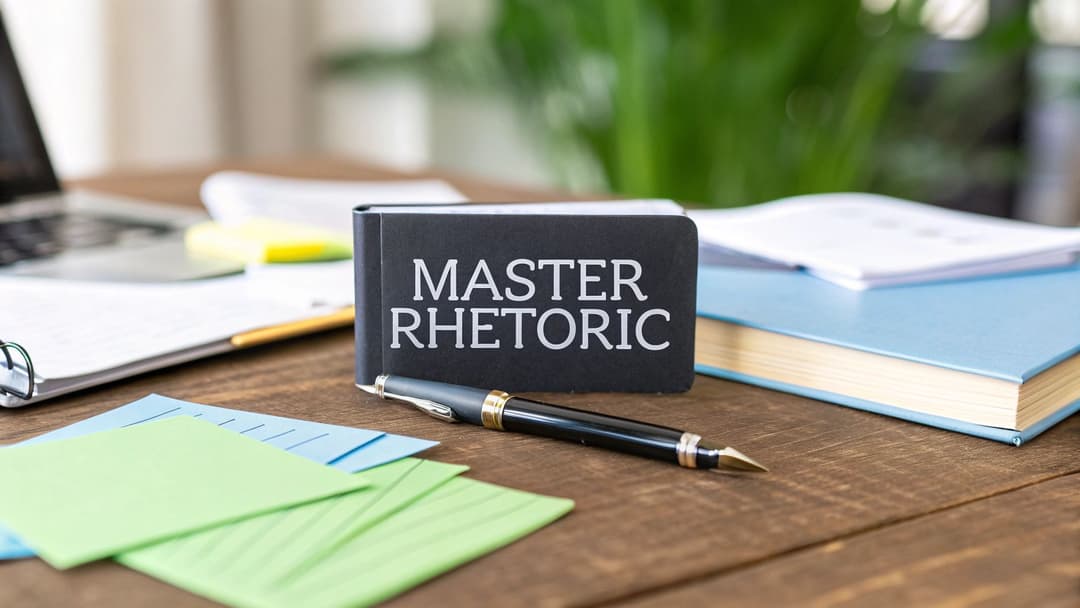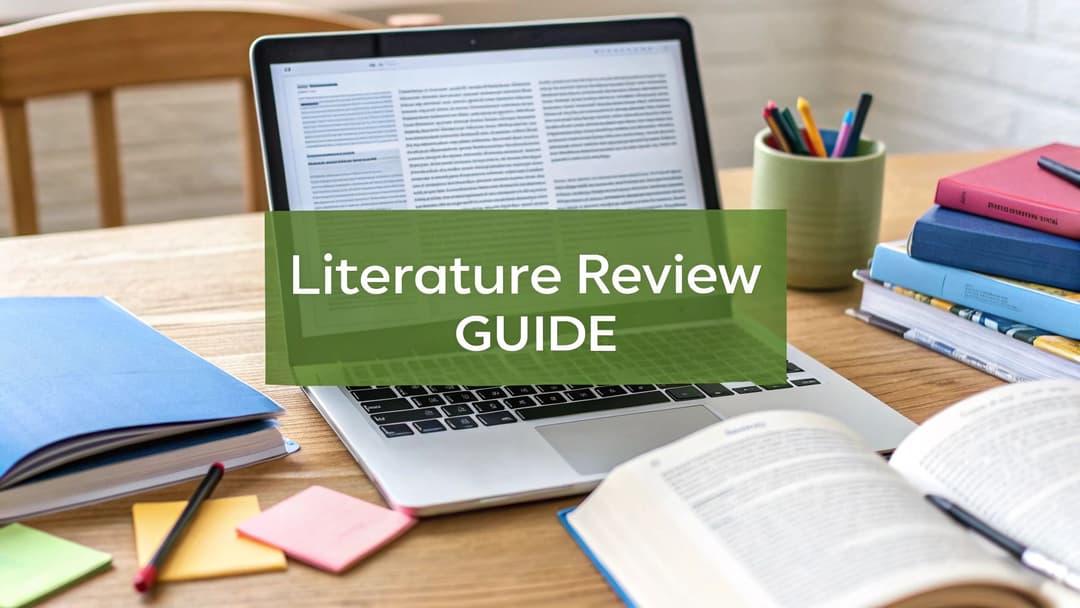
How Can I Rewrite This Sentence Better
August 30, 2025
We've all been there. Staring at a sentence, knowing it's just not hitting the mark. It's a universal writer's itch.
The secret to answering "how can I rewrite this sentence?" isn't just about catching typos. It’s about chasing clarity, impact, and flow. It's the difference between a weak statement and one that actually does its job.
Why Better Sentences Change Everything

Fixing a single sentence is rarely about just being "correct." It’s about making something happen. A well-crafted sentence can convince a client, simplify a dense topic, or just keep someone reading for one more second.
On the flip side, a clunky sentence can bury your message and tank your credibility.
This guide goes way beyond a simple spell check. We're getting into real, actionable strategies you can use to fix common writing problems and make every word count.
The Real Impact of Strong Writing
Let's be clear: effective writing isn't some stuffy academic skill. It's a critical tool in almost any job you can think of. The demand for clear, engaging communication has never been higher.
Just look at the numbers. The content writing services market was valued at around USD 22.63 billion in 2025 and is on track to hit USD 35.63 billion by 2032. That’s a massive jump, and it shows just how much businesses value writing that works.
This guide focuses on the building blocks of that kind of quality. You’ll learn how to:
- Boost Clarity: Cut through the fog so your message lands instantly.
- Increase Engagement: Write sentences that grab a reader's attention and don't let go.
- Strengthen Persuasion: Structure your thoughts in a way that actually influences people.
Rewriting isn't just about fixing mistakes; it's about unlocking the full potential of your ideas. Every edit is an opportunity to make your message resonate more deeply with your audience.
If you're looking for a broader overview on leveling up your writing game, check out these proven ways to improve writing skills.
For now, let's start transforming your writing, one sentence at a time.
Cut the Clutter to Find Your Clarity
One of the quickest ways to fix a weak sentence is to make it shorter. Strong writing is lean. Every single word has a job to do. So many drafts are weighed down by unnecessary words—filler words—that dilute the point and make your reader work way too hard.
Words like just, actually, really, and basically are common culprits. They feel conversational, sure, but they almost never add real meaning. When you cut them, the sentence instantly gets stronger.
Before: "I just think that we should actually move forward with the project." (12 words)
After: "I think we should move forward with the project." (9 words)
See? That small change adds confidence and gets straight to the point. The trick is to hunt down these weak words and get rid of them. No mercy.
Turn Clunky Nouns into Strong Verbs
Another thing that kills clarity is something called a nominalization. It sounds technical, but it’s simple: it’s what happens when you turn a perfectly good verb into a clunky noun. This bad habit makes sentences feel stuffy, formal, and passive.
For example, why say "make a decision" when you can just say "decide"? Once you start seeing these, you can’t unsee them. It's a game-changer.
Keep an eye out for these common ones:
- Provide a review becomes review
- Give consideration to becomes consider
- Make an announcement becomes announce
Turning these nouns back into verbs injects energy and trims the word count at the same time.
Before: "The team will conduct an investigation of the issue." (9 words)
After: "The team will investigate the issue." (6 words)
When you swap weak noun phrases for their original verbs, you bring life and momentum back into your writing. This simple shift is one of the most powerful edits you can make.
Once you’ve trimmed the fat, you can polish what’s left. Applying essential proofreading tips ensures your newly concise sentences are also free of errors. This one-two punch—cutting filler and strengthening verbs—is how you start to answer the question, "how can I rewrite this sentence?" for real impact.
Of course, after you've nailed conciseness, you'll want to think about rhythm. For that, check out our guide on how to vary sentence structure to give your writing a more engaging, natural flow.
Make Your Writing More Dynamic with Active Voice

If there’s one quick fix that dramatically improves your writing, it’s choosing the active voice over the passive voice. This isn’t just some dusty grammar rule; it's a strategic move that makes your sentences more direct, punchy, and clear.
When you use the active voice, you put the "doer" of the action front and center. This creates a much stronger and more engaging experience for your reader.
On the other hand, the passive voice often feels distant, bureaucratic, and a little evasive. It describes something happening without clearly saying who did it, which can make your writing feel weak.
Just look at the difference:
- Passive: "The report was submitted by the marketing team."
- Active: "The marketing team submitted the report."
See that? The active version is shorter, stronger, and leaves no room for doubt. It gives the sentence a clear subject that owns the action. It's a total game-changer when you're trying to figure out how to rewrite a sentence for more impact.
How to Spot and Fix Passive Voice
Finding passive voice gets easier the more you do it. A dead giveaway is looking for forms of the verb "to be" (like is, was, were, been) followed by a past-tense verb, often ending in "-ed" or "-en."
Another clue is that the person or thing doing the action is either missing entirely or tacked on at the very end with the word "by."
Once you've spotted it, the fix is usually pretty simple: find out who's doing the action and make them the subject of the sentence.
Passive voice sentences can feel like they're hiding something. Shifting to the active voice not only makes your writing clearer but also shows confidence and ownership. That builds trust with your reader.
But Is Passive Voice Always Bad?
Nope. While you'll want to use the active voice 90% of the time, the passive voice has its moments. It’s actually the better choice when the person performing the action is unknown, irrelevant, or just less important than the action itself.
For example, "My car was stolen last night" works much better than "Someone stole my car last night." The focus here is on the car, not the unknown thief.
Knowing when to use each voice gives you total control over the tone and focus of your sentences.
Using Modern Tools as Your Writing Co-Pilot
You don't have to stare at a sentence wondering how to fix it on your own. Modern writing tools, from grammar checkers to full-blown AI assistants, can act as a second pair of eyes, spotting issues you might miss during a manual review.
These tools are much more than spell checkers. They can suggest alternative phrasing to improve clarity, flag overly long or complex sentences, and even help you adjust the tone of your writing for different audiences. The goal isn't to let a machine take over, but to use its suggestions to refine your own work more efficiently.
Think of it as having an editor who can offer instant feedback, helping you make smarter, faster revisions.

As you can see, the time spent on different revision tasks adds up quickly, which is exactly where AI assistance can make the biggest difference.
How to Use Writing Tools Effectively
The key is to stay in the driver's seat. Treat AI suggestions as options, not commands. Always review them to make sure they align with your original meaning and preserve your unique voice. This critical thinking step is what separates a good writer from someone who just accepts every automated change.
Some tools can speed up the process in other ways, too. For instance, figuring out how to integrate speech-to-text into your workflow for productivity is a great way to get first drafts down quickly, leaving you more time for careful editing later on.
The adoption of these tools is already happening on a massive scale. In fact, 57.4% of content marketers now use AI for drafting and rewriting sentences.
Manual vs AI-Assisted Sentence Rewriting
Deciding whether to rewrite by hand or use an AI tool often comes down to balancing control with efficiency. Each approach has its place.
| Aspect | Manual Rewriting | AI-Assisted Rewriting |
|---|---|---|
| Control | Full control over voice, tone, and nuance. Every word is intentional. | Suggestions may not perfectly match your voice; requires review. |
| Speed | Slower and more methodical. Can be time-consuming for large projects. | Significantly faster, generating multiple options in seconds. |
| Creativity | Relies entirely on your own creativity and vocabulary. | Can introduce new phrasing and ideas you might not have considered. |
| Consistency | Can be challenging to maintain a consistent tone across long documents. | Helps maintain consistency by applying similar stylistic rules. |
| Learning Curve | No learning curve beyond developing your own writing skills. | May require some time to learn the tool and how to write effective prompts. |
Ultimately, the best approach often involves a blend of both. You can use an AI tool to generate ideas or handle repetitive edits, then step in to add the final human touch that makes the writing truly yours.
A writing tool is a collaborator, not a replacement. Use it to generate ideas, catch errors, and speed up your workflow, but always make the final call yourself. Your judgment is what makes the writing truly yours.
By combining human creativity with machine efficiency, you can produce higher-quality work in less time. It’s all about working smarter, not harder.
Advanced Strategies for Impact and Flow

Alright, once you've trimmed the fat and swapped in stronger verbs, it's time to get into the artistry of writing. Great writing isn't just about clear words; it has a certain rhythm, a kind of musical quality that keeps the reader hooked.
You create this effect by intentionally mixing up your sentence length and structure. A short, punchy sentence can land a key point with real power. A longer, more descriptive one can then sweep in to build out the context. It's this back-and-forth that prevents your writing from sounding flat and monotonous.
Create Rhythm with Parallel Structure
One of the best ways to build that rhythm is with parallel structure. This is just a fancy way of saying you use the same grammatical pattern for related ideas. It's a simple trick that adds both clarity and a satisfying cadence to your sentences.
For instance, instead of writing, "She likes running, to swim, and she also enjoys hiking," a parallel version tightens it up: "She likes running, swimming, and hiking." See how that little change makes the sentence flow so much better? It’s smoother and just sticks in your head.
Parallelism isn't just a grammar rule; it's a tool for persuasion. By aligning your ideas grammatically, you create a sense of balance and importance that makes your message more impactful.
This stuff really matters in the professional world. Content marketing is on track to generate over $107 billion by 2026, and with 91% of B2B marketers all-in on content, good writing is non-negotiable. We've seen that high-quality content, often polished through rewriting, is directly linked to a 72% increase in lead generation.
Reorder Clauses to Shift Focus
Here's another pro move: reordering clauses to control where the reader's attention goes. If you want an idea to hit hard, try placing it at the very end of the sentence. It naturally gives the thought more weight.
It’s these kinds of subtle adjustments that separate good writing from great writing. If you want a full deep dive on these techniques, check out our guide on how to rewrite a sentence for maximum effect.
Let's See It in Action: A Real-World Rewrite
Theory is great, but seeing these principles work in the real world is where it all clicks. The best way to understand how to transform weak writing is to actually do it.
So, let's take a clunky, poorly written paragraph and rework it together.
Here’s our starting point. You’ve probably seen something like this in a business report or a project update email:
Original Paragraph: "It has been decided by the project team that a review of the new software will be conducted next week. The software’s performance issues were reported by several users, and it is imperative that a solution is found quickly by us. The goal is the complete implementation of the system before the end of the quarter, which is a deadline that is fast approaching."
This thing is a mess. It's passive, wordy, and has zero confidence. Let's fix it.
The Rewriting Process, Step by Step
First things first, we need to kill the passive voice and trim the fat. Sentences like "It has been decided by the project team" are classic signs of weak, indirect writing. By making the team the subject of the sentence, we instantly add clarity and ownership.
Here’s how we tackle it:
- Change 1: "It has been decided by the project team..." becomes "The project team decided..."
- Change 2: "...a review of the new software will be conducted..." becomes "...to review the new software..."
- Change 3: "...a solution is found quickly by us" becomes "we must find a solution quickly."
See? Those small edits already make a huge difference.
Now, we just need to combine these stronger phrases, vary the sentence structure a bit, and make sure the whole paragraph flows naturally.
Here’s the final, polished version:
Revised Paragraph: "The project team will review the new software next week. Several users reported performance issues, so we must find a solution quickly. Our goal is to implement the system completely before the fast-approaching end-of-quarter deadline."
The new version is shorter, more direct, and just plain easier to read. This is exactly what you should aim for every time you ask yourself, "how can I rewrite this sentence?" The goal is to make your message stronger and clearer with every single edit.
Got Questions About Rewriting Sentences?
Even when you have a plan, a few questions always seem to pop up in the middle of a rewrite. Let's tackle some of the most common ones I hear.
What’s the Quickest Way to Fix a Sentence?
If you need a fast fix, an AI writing tool is often your best bet. It can spit out a handful of different options in a few seconds, letting you pick what sounds best.
But if you’re rewriting manually, the single biggest bang for your buck comes from flipping a passive sentence into an active one. It’s a small change that makes your writing instantly stronger and clearer.
How Do I Rewrite Something Without Changing the Meaning?
The trick here is to separate the idea from the delivery. You want to keep the core message intact while changing how you present it.
Focus on the sentence structure and your word choices. Try swapping out bland adjectives for more powerful synonyms or reordering the clauses to change the rhythm.
Think of it this way: the core of your message stays the same, but the delivery becomes more effective. It’s like presenting the same data in a clearer, more persuasive chart.
Does Rewriting Sentences Actually Help with SEO?
Yes, it absolutely does. When you rewrite your sentences to be clearer and more readable, you're directly improving the experience for your reader.
Better engagement is a huge signal to search engines that your content is valuable. This can lead to more shares, more backlinks, and, ultimately, better rankings over time.
Learning how to rewrite sentences is just one piece of the puzzle. For a deeper dive into other strategies, check out our complete guide to improve your writing skills.
Struggling to humanize your AI-generated drafts? Natural Write transforms robotic text into natural, engaging content that bypasses AI detectors with a single click. Refine your essays, marketing copy, and blog posts instantly at https://naturalwrite.com.


